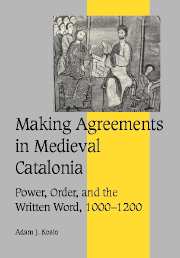29 results
The Peace of God. By Geoffrey Koziol. Past Imperfect. Leeds: ARC Humanities Press, 2018. x + 141 pp. $14.95 paper.
-
- Journal:
- Church History / Volume 88 / Issue 1 / March 2019
- Published online by Cambridge University Press:
- 20 May 2019, pp. 206-207
- Print publication:
- March 2019
-
- Article
- Export citation
Ernst Kantorowicz: A Life. By Robert E. Lerner . Princeton, NJ: Princeton University Press, 2017. Pp. xv + 400. Cloth $39.95. ISBN 978-0691172828.
-
- Journal:
- Central European History / Volume 50 / Issue 4 / December 2017
- Published online by Cambridge University Press:
- 29 December 2017, pp. 584-586
- Print publication:
- December 2017
-
- Article
- Export citation
Rémy Ambühl. Prisoners of War in the Hundred Years War: Ransom Culture in the Late Middle Ages. Cambridge: Cambridge University Press, 2013. xiv + 302 pp. $99. ISBN: 978-1-107-01094-9.
-
- Journal:
- Renaissance Quarterly / Volume 67 / Issue 1 / Spring 2014
- Published online by Cambridge University Press:
- 20 November 2018, pp. 254-255
- Print publication:
- Spring 2014
-
- Article
- Export citation
10 - Sicut mos esse solet: documentary practices in Christian Iberia, c. 700–1000
-
-
- Book:
- Documentary Culture and the Laity in the Early Middle Ages
- Published online:
- 05 December 2012
- Print publication:
- 22 November 2012, pp 259-282
-
- Chapter
- Export citation
Contributors
-
-
- Book:
- Documentary Culture and the Laity in the Early Middle Ages
- Published online:
- 05 December 2012
- Print publication:
- 22 November 2012, pp viii-viii
-
- Chapter
- Export citation
Documentary Culture and the Laity in the Early Middle Ages - Title page
-
-
- Book:
- Documentary Culture and the Laity in the Early Middle Ages
- Published online:
- 05 December 2012
- Print publication:
- 22 November 2012, pp iii-iii
-
- Chapter
- Export citation
6 - WRITING AND POWER
-
- Book:
- Making Agreements in Medieval Catalonia
- Published online:
- 09 July 2009
- Print publication:
- 03 May 2001, pp 268-294
-
- Chapter
- Export citation
3 - KEEPING AGREEMENTS
-
- Book:
- Making Agreements in Medieval Catalonia
- Published online:
- 09 July 2009
- Print publication:
- 03 May 2001, pp 121-157
-
- Chapter
- Export citation
Map
-
- Book:
- Making Agreements in Medieval Catalonia
- Published online:
- 09 July 2009
- Print publication:
- 03 May 2001, pp xx-xx
-
- Chapter
- Export citation
Frontmatter
-
- Book:
- Making Agreements in Medieval Catalonia
- Published online:
- 09 July 2009
- Print publication:
- 03 May 2001, pp i-vi
-
- Chapter
- Export citation
Works cited
-
- Book:
- Making Agreements in Medieval Catalonia
- Published online:
- 09 July 2009
- Print publication:
- 03 May 2001, pp 315-345
-
- Chapter
- Export citation
List of tables
-
- Book:
- Making Agreements in Medieval Catalonia
- Published online:
- 09 July 2009
- Print publication:
- 03 May 2001, pp x-x
-
- Chapter
- Export citation

Making Agreements in Medieval Catalonia
- Power, Order, and the Written Word, 1000–1200
-
- Published online:
- 09 July 2009
- Print publication:
- 03 May 2001
Subject index
-
- Book:
- Making Agreements in Medieval Catalonia
- Published online:
- 09 July 2009
- Print publication:
- 03 May 2001, pp 362-366
-
- Chapter
- Export citation
2 - MAKING AGREEMENTS
-
- Book:
- Making Agreements in Medieval Catalonia
- Published online:
- 09 July 2009
- Print publication:
- 03 May 2001, pp 78-120
-
- Chapter
- Export citation
Index of names
-
- Book:
- Making Agreements in Medieval Catalonia
- Published online:
- 09 July 2009
- Print publication:
- 03 May 2001, pp 346-361
-
- Chapter
- Export citation
Table of published documents
-
- Book:
- Making Agreements in Medieval Catalonia
- Published online:
- 09 July 2009
- Print publication:
- 03 May 2001, pp 295-314
-
- Chapter
- Export citation
5 - FORTUNES (THE TWELFTH CENTURY)
-
- Book:
- Making Agreements in Medieval Catalonia
- Published online:
- 09 July 2009
- Print publication:
- 03 May 2001, pp 219-267
-
- Chapter
- Export citation
Cambridge Studies in Medieval Life and Thought Fourth series
-
- Book:
- Making Agreements in Medieval Catalonia
- Published online:
- 09 July 2009
- Print publication:
- 03 May 2001, pp 367-369
-
- Chapter
- Export citation
Note on citations, dates, and names
-
- Book:
- Making Agreements in Medieval Catalonia
- Published online:
- 09 July 2009
- Print publication:
- 03 May 2001, pp xiii-xiv
-
- Chapter
- Export citation



